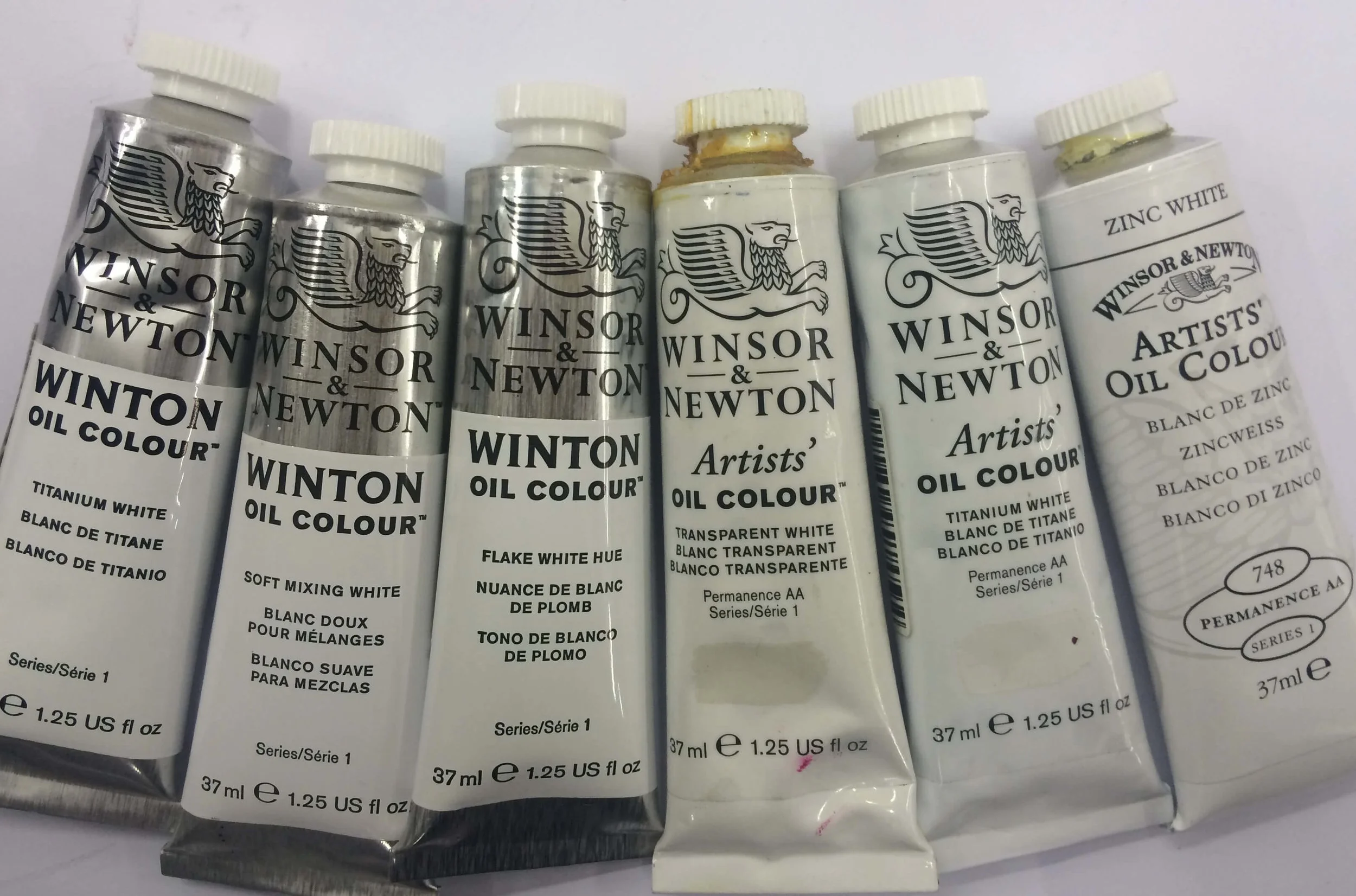“Women think of all colors except the absence of color. I have said that black has it all. White too. Their beauty is absolute. It is the perfect harmony.”
The array of whites available can quickly become confusing! This post shares information about various whites and what you need to keep in mind when choosing whites. it also includes links to other sites if you want to get more technical information and see photos of experiments in white.
Below are the whites available at my local art shop. Take careful note of the pigments and vehicles used within the paint as shown in the second image and apply that to the paint available in your local art shop.
Winsor & Newton: Titanium White | Winton Series 1; Soft Mixing White | Winton Series 1; Flake White Hue | Winton Series 1; Transparent White | Artists', Permanence AA, Series 1; Titanium White | Artists', Permanence AA, Series 1; Zinc White | Artists', Permanence AA, Series 1
Winsor & Newton: Titanium White | Winton Series 1; Soft Mixing White | Winton Series 1; Flake White Hue | Winton Series 1; Transparent White | Artists', Permanence AA, Series 1; Titanium White | Artists', Permanence AA, Series 1; Zinc White | Artists', Permanence AA, Series 1
Curious about what pigments like PW6 are (as shown above in the snapshot of Windsor and Newton paints)? This website has an incredible database of colour and pigments! Here is the link to their page: The Color of Art Pigment Database: Pigment White, PW.
PW6 is a titanium dioxide while PW4 is a zinc oxide.
Flake white (PW1, PW4) is ideal in under painting as well as mixing with higher oil content colours. This white dries rapidly which results in hard, flexible and durable paint films. Most Flake White that we buy today is a Flake White Hue, thus only resembling the original, as the original is made from white lead, and is highly toxic to work with. It is only available in an oil medium, and usually contains zinc to improve its consistency. It is also one of the stiffest whites. Flake White Hue (PW6, PW4), is a titanium based formulation but has a lower tinting strength than Titanium White. It is also known for drying quickly.
"May cause harm to the unborn..."
Titanium white (PW6, PW4) is the most popular modern white and is opaque in quality and softer than Flake White. It is also less prone to cracking than Zinc White. Titanium White is often described as chalky because of its powdery appearance. Titanium white is extremely opaque and will thus obliterate any transparency when being used as a lightener. It can also have a graying effect when mixed into a colour that has been mixed from several colours. A general rule to follow to prevent a gray effect/ keep up the vibrancy of colours, is to only mix titanium white with single pigment paints.
Zinc white (Zinc Oxide, PW4) in contrast is the least opaque white, and almost the only modern popularly used white that does not contain titanium. Zinc white works well for transparent applications as well as for glazing, it is also a stiff white.
Other common and uncommon whites:
Soft Mixing White (PW6, PW4) - a titanium based white which is soft and has lower tinting properties than pure titanium white.
Transparent White (PW6, PW4) - also titanium based, but has extremely low tinting properties
Cremnitz White - (PW1) a lead based white, without any addition of zinc, giving the white a stringy consistency.
Iridescent White - (PW 20 - Hydrous Aluminium Potassium Silicate) a mica based pigment giving a pearlescent quality to the paint. Effective when used to lighten transparent colours.
Most whites are thus very similar in composition, both containing Titanium and Zinc, it is thus also possible to mix any titanium-zinc based white with a tube of both and a vehicle such as safflower or linseed.
Lastly, on vehicles. As seen all the WN whites use safflower as a vehicle instead of linseed, this is said to reduce the amount that a white will yellow over the years, this is thus also a key point in selecting a white. An interesting experiment by artist and blogger Jonathan Linton found here, shows how different types and brands of white age over the years.
“I don’t paint people and things; I paint the way light reacts to people and things. This brings me to the basics about light and dark. ”
Close-up from John Singer Sargent’s Margaret Stuyvesant Rutherford White, 1883
Corcoran Gallery of Art, Washington D.C
Oil on canvas
221 x 138.7 cm
This close up taken from John Singer Sargent’s oil on canvas Margaret Stuyvesant Rutherford White, shows his exquisite use of white, but also the lack of white in a very white dress. The way white is utilised and in contrast to what colours it is placed, is what renders the use of white successful or not.





